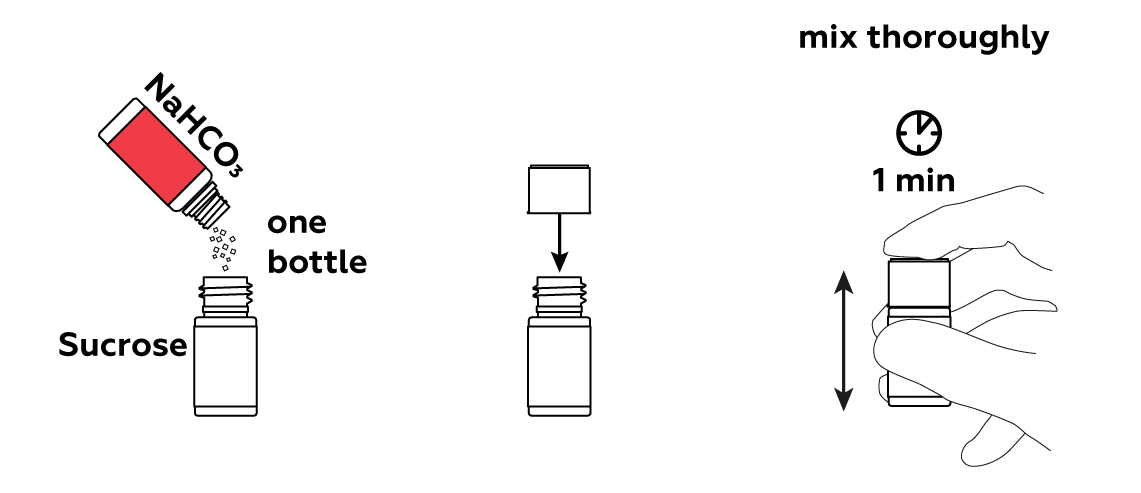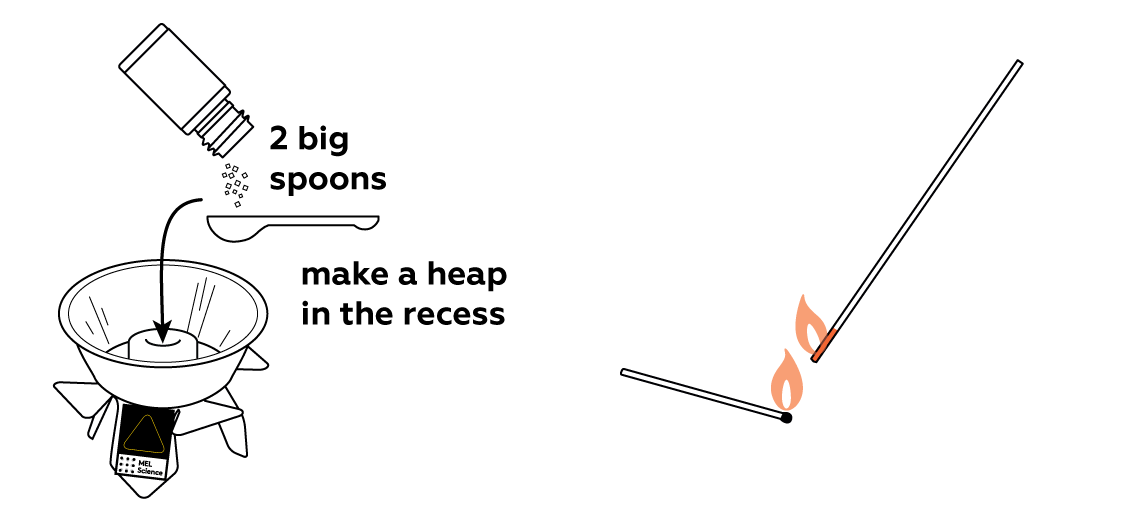Sugar snake
Grow a black snake out of sugar!
Reagents
Safety
- Put on protective eyewear.
- Conduct the experiment in a well-ventilated area.
- Keep a bowl of water nearby while working with fire.
- Keep flammable materials and hair away from the setup.
- Do not attempt to extinguish the solid fuel — let it burn down completely.
- Do not touch the burner after the experiment — wait until it cools down.
- Do not allow chemicals to come into contact with the eyes or mouth.
- Keep young children, animals and those not wearing eye protection away from the experimental area.
- Store this experimental set out of reach of children under 12 years of age.
- Clean all equipment after use.
- Make sure that all containers are fully closed and properly stored after use.
- Ensure that all empty containers are disposed of properly.
- Do not use any equipment which has not been supplied with the set or recommended in the instructions for use.
- Do not replace foodstuffs in original container. Dispose of immediately.
- In case of eye contact: Wash out eye with plenty of water, holding eye open if necessary. Seek immediate medical advice.
- If swallowed: Wash out mouth with water, drink some fresh water. Do not induce vomiting. Seek immediate medical advice.
- In case of inhalation: Remove person to fresh air.
- In case of skin contact and burns: Wash affected area with plenty of water for at least 10 minutes.
- In case of doubt, seek medical advice without delay. Take the chemical and its container with you.
- In case of injury always seek medical advice.
- The incorrect use of chemicals can cause injury and damage to health. Only carry out those experiments which are listed in the instructions.
- This experimental set is for use only by children over 12 years.
- Because children’s abilities vary so much, even within age groups, supervising adults should exercise discretion as to which experiments are suitable and safe for them. The instructions should enable supervisors to assess any experiment to establish its suitability for a particular child.
- The supervising adult should discuss the warnings and safety information with the child or children before commencing the experiments. Particular attention should be paid to the safe handling of acids, alkalis and flammable liquids.
- The area surrounding the experiment should be kept clear of any obstructions and away from the storage of food. It should be well lit and ventilated and close to a water supply. A solid table with a heat resistant top should be provided
- Substances in non-reclosable packaging should be used up (completely) during the course of one experiment, i.e. after opening the package.
FAQ and troubleshooting
This can happen if you cover the tablet of solid fuel with too much sugar and NaHCO3. Use a wooden stick to carefully brush any excess away from the sides of the tablet, then try to light the solid fuel.
Apparently, your snake was very impressive! Be sure to wait till everything cools down and the thermosticker turns black. Then you can clean everything up and dispose of the snake with household waste.
The “reptilian” compounds are perfectly safe, so you can dispose of them with ordinary household waste.
Step-by-step instructions
Put your pocket burner on the safety underlay.

Mix some sodium hydrogen carbonate NaHCO3 with sugar.

Put a solid fuel tablet on the stove.

Put your mixture into the tablet.

Ignite the tablet and observe.

Disposal
Dispose of solid waste together with household garbage.
Scientific description
When we set the solid fuel on fire, a whole range of chemical transformations takes place – culminating in a small heap of white powders turning into a huge black snake!
In fact, each substance undergoes its own transformations: the solid fuel burns, yielding almost exclusively gaseous products and a lot of heat. This heat makes the baking soda decompose to release carbon dioxide gas, and makes the sugar turn into black carbon. The carbon dioxide whips the carbon into a froth, giving it more and more volume and forming the spectacular snake that you see.
That’s interesting!
What is sugar and where does it come from?
A sugar molecule consists of carbon (C), oxygen (O), and hydrogen (H) atoms. The picture on the right shows what a typical sugar, sucrose, looks like.
The sucrose molecule is composed of two parts connected to each other by an oxygen atom (O). The two parts are glucose and fructose, which you may have heard of. Glucose and fructose are called simple sugars. Normal, household sugar is a complex sugar, which means that the sugar molecules consist of several (in this case, two) simple sugars.
The pictures below demonstrate what simple sugars look like.
Glucose | Fructose |
Sugars are important building blocks in plants. Plants produce simple sugars from water and carbon dioxide during photosynthesis. Simple sugars can be linked together to form small molecules, such as sucrose, or to form long chains. Starch and cellulose, for instance, are polysaccharides, i.e. they are long-chain sugars made up of simple sugars. Plants use sugars as building materials and for nutrient storage.